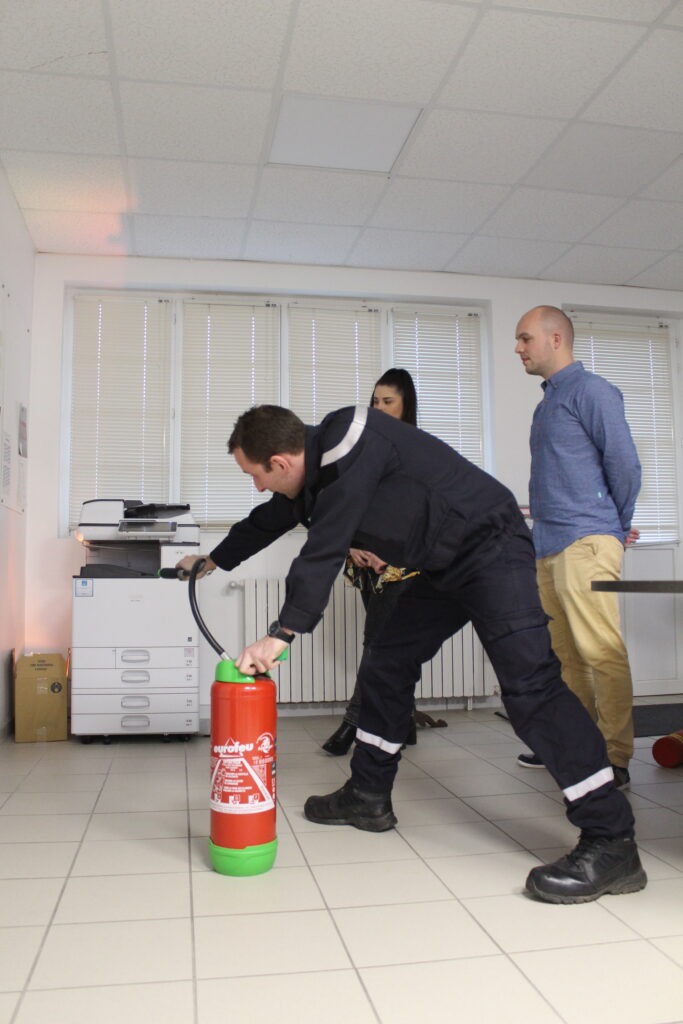What is the fire training program?

Fire training is essential to enhance safety in the workplace. It aims to make staff aware of the dangers of fire, teach them what to do if they discover a fire, and train them in the use of fire extinguishers. It also includes practical fire extinguishing and evacuation exercises. What's more, regulations require these drills to be repeated every six months. All in all, it's a comprehensive program for effective fire prevention and control.
Legal requirements for fire training
Regulations and labor code
Fire training in the workplace is governed by the French Labor Code, which imposes a number of obligations on employers. Among these, it is essential to guarantee safety in the event of an outbreak of fire. Articles R4227-28 to R4227-41 specify that all employees must be trained in fire-related risks.
Employers should organize regular drills to ensure that every member of staff knows how to react in an emergency situation. This includes handling fire extinguishers and knowing evacuation instructions. A common example is the organization of twice-yearly drills to test the effectiveness of evacuation procedures.
For larger companies, or those handling flammable materials, stricter measures need to be implemented. Employers are required to tailor training to the specific risks of their establishment.
Obligatory training for all staff
Fire training for all staff is a legal obligation, designed to ensure everyone's safety in the event of an incident. It must cover several essential aspects:
- Knowledge of evacuation instructions: every employee needs to know where the assembly point is and how to get there quickly.
- Handling fire extinguishers: familiarize personnel with different types of extinguishers for rapid, effective intervention.
- Recognizing fire alarms: it's crucial that all staff can identify the specific audible signal so they can react quickly.
One concrete example is the organization of quarterly evacuation drills, which enable acquired knowledge to be put into practice and ensure that disabled people are properly cared for. These regular training sessions help to improve employee responsiveness in the event of fire outbreaks, while complying with current safety standards.
The employer's role in risk prevention
Employers play a fundamental role in fire risk prevention. Not only must they comply with legal obligations, they must also encourage a proactive safety culture. Implementing preventive measures involves several essential steps:
- Risk assessment: Analysis of risk areas and identification of corrective measures.
- Employee training: Offer regular sessions to teach evacuation procedures and the use of safety equipment, such as fire extinguishers.
- Organization of practical exercises: Fire simulations to test staff responsiveness and adjust procedures if necessary.
A concrete example would be to appoint first-response team members, trained to react quickly in the event of an emergency. These actions demonstrate the employer's commitment to employee safety and business continuity.
Fire training content
Learn how to use a fire extinguisher
To effectively master the use of an extinguisher, it's essential to understand the steps to follow when responding to a fire. First, identify the type of fire and choose the right extinguisher. Fire classes A, B, C, D and F determine the type of extinguisher to use.
Next, it's crucial to position yourself at a safe distance, generally between 3 and 4 meters from the fire. Make sure you maintain this distance to avoid risk. Pull the safety pin, direct the spray towards the base of the flames and press the handle in a sweeping motion.
Finally, we recommend practical training with real-life exercises to reinforce your skills. These courses enable you to familiarize yourself with different fire scenarios and ensure a rapid, effective response.
Discover the different types of fire
Fires can be classified into different types, depending on the material ignited. This classification is essential for choosing the right extinguishing media. Here are the main classes:
- Class A: for fires involving solid materials such as wood or paper.
- Class B: fires involving flammable liquids such as petrol or solvents.
- Class C: includes fires involving flammable gases such as propane.
- Class D: refers to metal fires, often encountered in industrial environments.
- Class F: for cooking oil and grease fires.
To extinguish a fire effectively, it's crucial to use the right extinguisher for its class. A water extinguisher is suitable for a Class A fire, while a powder extinguisher is more appropriate for a Class D fire.
Practical fire-fighting exercises
To perfect your emergency management skills, practical fire-fighting exercises are essential. They enable you to familiarize yourself with the use of equipment such as fire extinguishers and fire blankets. These exercises, often carried out under controlled conditions, involve the use of tools such as flame generators to simulate realistic scenarios.
Here are some key elements to integrate into these exercises:
- Alarm signal recognition: Ensure that all personnel can quickly identify the audible or visual signal.
- Use of extinguishers: Learn how to correctly handle the different types of extinguishers depending on the class of fire.
- Coordination and evacuation: Organize the evacuation by assigning specific roles, such as file guides and file clerks, to ensure an orderly and safe exit.
These drills reinforce staff responsiveness and efficiency in the face of a potential fire, guaranteeing greater safety for all.
Fire evacuation training
Fire evacuation training is essential to ensure a quick and safe exit. It teaches participants how to react to a fire, providing them with the skills they need to manage the evacuation effectively. Key steps include recognizing alarm signals and knowing evacuation routes.
Participants also learn how to identify the roles of guide and line-keeper, which are crucial in directing occupants to emergency exits. A good knowledge of evacuation plans and assembly points is also important.
Here are some of the key points covered during the course:
- Alarm signal: Understand its characteristics and function.
- Evacuation routes: How to use emergency exits.
- Specific roles: Leaders and closers for an orderly evacuation.
Training often includes practical exercises to simulate real-life situations, reinforcing participants' preparation.
First Response Teams (FIT) training
Role and responsibilities of PPE
First Response Teams (FRTs) play an essential role in corporate fire safety. They are often the first to react in the event of a fire. Their main task is to alert emergency services and limit material and human damage.
They must master the use of fire-fighting equipment such as extinguishers and RIAs. In addition, PPE plays a crucial role in the evacuation of premises, ensuring that all personnel leave the premises safely.
To be effective, IPEs undergo regular training covering various aspects of fire prevention and management. This training includes practical and theoretical exercises to reinforce their skills and responsiveness to an emergency situation. Their commitment is essential to ensure a rapid, coordinated response.
PPE training and certification
To become an effective First Responder, certified training is essential. Certified trainers provide comprehensive instruction in fire prevention and firefighting. This includes fire safety procedures, as well as the use of fire extinguishers and RIAs.
Certification courses aim to develop practical and theoretical skills. A complete program could include :
- Fire theory: understanding the causes and mechanisms of fires.
- Extinguishing techniques: know how to handle different types of extinguishers.
- Evacuation management: learning how to guide colleagues safely.
Some sessions take place on site to provide a realistic experience. At the end of the training, a certificate is often issued, confirming the acquisition of the skills needed to ensure safety within the company.
Practical exercises for PPE
To reinforce the skills of First Response Teams (FRT), a variety of practical exercises are essential. These activities provide the practical experience needed to respond effectively to a fire.
Exercises often include realistic simulations, using different types of extinguisher and various fire scenarios. For example, participants can practice extinguishing a Class A fire with a water extinguisher. What's more, exercises under simulated conditions help IPEs to get to grips with technical gestures and better manage stress.
To make these training sessions more engaging, dynamic role-playing scenarios are used. This enables team members to improve their coordination and rapid decision-making. Regular practice builds confidence and ensures rapid response to emergencies.


